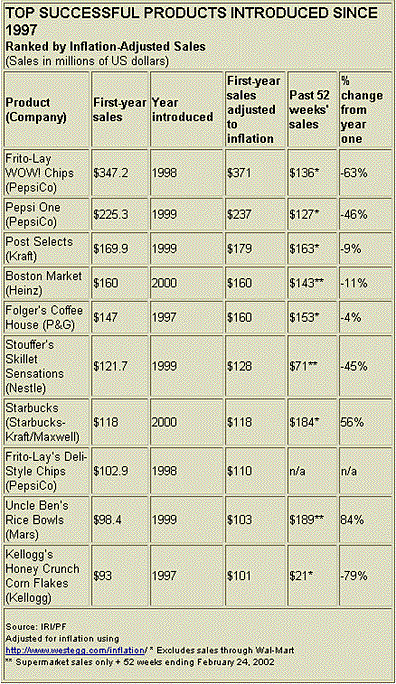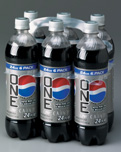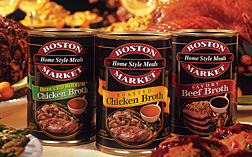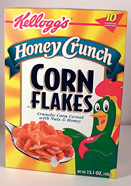While sales figures have played a notable role in the selection process, past years' honorees also have boasted innovative marketing strategies, packaging and formulation technologies, created new categories and/or successfully extended a line. Certainly, any number of last year's product introductions would make for an excellent list based on those criteria, with Chex Morning Mix, Uncle Ben's bowl extensions, various introductions from Heinz, Borden's Cheese & Macaroni, and others, all in the running.
However, a look back at recent, successful introductions provides hindsight into what made these products a success, what audience they attracted and how they have fared in the crowded marketplace—kind of like looking up old friends and seeing how the years have treated them. Some products jumped on the healthful bandwagon. Others capitalized on a familiar name and brand. Which proved the wiser course? -Eds.

WOW: Pronounced 'Whoa'?
Frito-Lay, Plano, Texas, certainly hit the nail on the head when it opted to highlight the fact its snack extensions were made with the fat substitute Olestra. WOW would debut in Ruffles Cheddar & Sour Cream and Tostitos Restaurant Style Tortilla Chips, with Lay's and Dorito's versions following shortly. The line proved an immediate success, as Information Resources Inc. (IRI) lauded the line its “New Product of the Year.” The June 1999 issue ofPrepared Foodscommented, “The success of WOW Chips blazes new trails for food product development and debunks a number of myths along its way.”Those new trails were forged with Olestra, allowing the WOW chips to be fat-free with taste and textural purity. The new generation of fat substitute featured “sugar polyesters manufactured by attaching fatty acids to sugar molecules, from which they cannot be cleaved by human lipase enzymes,” reported this magazine. “As a result, the bulky sugar-esterified fatty acid molecules are not absorbable through the human intestine and are fully excreted.” This may have been to WOW's advantage but would, ultimately, prove to be its nemesis.
Success was immediate, if not fleeting. First-year sales totaled $347.2 million in 1998 dollars, but IRI has noted steady declines in WOW sales in the years since, with $219 million in 1999, $149 million in 2000 and $136 million over the past 52 weeks. (Note: IRI excludes Wal-Mart sales from their tallies.) The decline has led Frito-Lay to ponder what once would have been unthinkable.

Olestra requires a licensing fee to Procter & Gamble, likely boosting the cost to produce WOW chips beyond that of similar Frito-Lay items. Add this to the fact that Frito-Lay brands such as Lay's, Doritos and Tostitos can each fetch more than $1 billion in annual sales, and it is apparent why the company would consider dropping a relative underperformer. PepsiCo/Frito-Lay did not return phone calls to ascertain the status of their products.
Nonetheless, WOW's strongest virtue may have been the key to its demise. Olestra made the product a fat-free treat, but a public-health group, the Center for Science in the Public Interest, Washington, lobbied to ban the ingredient, arguing that some consumers required emergency-room treatment after suffering side effects. The FDA would require products made with Olestra to have a warning label: “May cause abdominal cramping and loose stools.” Frito-Lay is not alone in feeling the sting of the label; P&G's own Pringles Fat-Free line made with the ingredient also has fallen on hard times.
As Caroline Levy, an analyst with UBS Warburg, Chicago, believes, “(Olestra) was going to be a revolutionary product, but it never got off the ground—and never will with that kind of a label.” The same may well be said of WOW.

The One and Only
Pepsi, Purchase, N.Y., reportedly spent more than $100 million to launch Pepsi One in October 1998, supposedly with a first-year retail sales goal of $1 billion, a benchmark that the company later admitted was “overblown.” This low-calorie soft drink tried a different tactic for diet drinks—targeting young male consumers. The real innovation in Pepsi One was its use of Sunett sweetener, the first ready-to-drink beverage in the U.S. to feature the ingredient also known as acesulfame potassium, or Ace-K.Promising the taste of a full-calorie soda with only one calorie, Pepsi One had a strong start, with retail sales of more than $225 million in 1999 dollars ($237 million adjusted for inflation). That level of success would not last long, however, as Pepsi One's sales have dipped to $127 million over the last 52 weeks. Timing seems to have been Pepsi One's undoing.
The one-calorie soda launched at the height of the health food trend, but also followed another trend—that of “healthy” snacks that debuted strongly, but faded as consumers returned to foods packed with more salt, sugar, calories and fat.

Taking the Post
Consumers' move toward indulgence has had less of an impact in one area—the breakfast table. In fact, one recent success is considered “healthy” and has managed to retain much of its first-year sales. Kraft Foods', Glenview, Ill., Post cereals division debuted Post Selects in 1999 in four varieties—Banana Nut Crunch, Cranberry Almond Crunch, Blueberry Morning and Great Grains—each high in folic acid and providing at least nine essential vitamins and minerals. Post used high-quality ingredients in the Selects line, which featured real Ocean Spray cranberries, big pecans and multi-grain flakes; the company says it tried to make a line of cereals that consumers would make for themselves if they had the time and ingredients.Post developed the line internally, but the process would require R&D teams from both Post and Kraft Foods. Each individual variety was launched as its own brand in the early 1990s and, according to Doreen Stephens, vice president of strategy with Post Cereals and Desserts, consumers responded to the heightened textural variety, as well as to the complexity of ingredients and distinctive flavor profiles.
After discovering consumers were responding to these products, Post opted to group them under one brand in the company's portfolio. Thus, Morning Traditions was born in 1996 and renamed Post Selects in 1998, when the line garnered total one-year sales of $169.9 million ($179 million adjusted for inflation). Those sales have held fairly steady, as the line boasted just over $163 million in retail sales over the past 52 weeks.
The line did present Post with a surprise, however, albeit a pleasant one. “Consumers who liked one would try another,” says Stephens. “It pulls together brands that are unique in their own right, but also very similar, so consumers, when they find one brand within the Post Selects line that they like, realize there are several others that could be equally appealing.”

In the Market
A number of foodservice brands have made the transition into retail. So, H.J. Heinz, Pittsburgh, Pa., must have known it had a sure-fire hit with the Boston Market Frozen Meals project—at least until mid-way through development when the licensor, Boston Chicken Inc., filed for Chapter 11 bankruptcy protection. Heinz opted to press on and would find the company's greatest success.
The 16-SKU line, forged on built-in brand awareness, registered $160 million in year-one sales, which dropped slightly to $143 million over the past 52 weeks. Nonetheless, the line is well ahead of targeted sales of roughly $200 million over its first two years. Not too bad, considering Heinz paid $3 million in cash and roughly $30 million in a 10-year royalty deal for rights to use the Boston Market name, key in retaining customer loyalty.

License to Drive—Growth
Kraft Foods took a similar route to success when partnering with coffeehouse powerhouse Starbucks in late 1998. David Sachs, category business director for specialty businesses at Kraft, makes no bones about why the retail line of Starbucks was so successful: “It really comes back to the fact that Starbucks makes great coffee.”While whole bean coffee is available in its stores, Starbucks' problem was that many people who buy coffee beans from grocery stores had somewhat limited (or no) access to the Starbucks product. Enter Kraft, who through a licensing agreement with the coffeehouse, exposed the brand to a new consumer base.
Rather than cannibalizing upon the coffeehouse business, Kraft feels the Starbucks coffee has actually managed to expand upon an already firmly established—and fiercely loyal—consumer base, one which has been 20 years in the making. With the mindset that coffee drinkers are set in their ways, Kraft sought to target those consumers who only buy their coffee in grocery stores—but with a twist. “We've given them access to a better coffee experience at home,” Sachs says.
Beginning in the mid-1990s, Kraft saw the advent and rising popularity of super-premium coffees, a trend occurring largely outside of the grocery store. Leading that super-premium trend was Starbucks.
Sachs recalls how well the strengths of each company complemented each other—Starbucks' great brand and product, plus Kraft's distribution strengths and sales force. “Here was an opportunity to combine the very powerful—very complementary—attributes of our companies and really drive success, which is what we've done.”
Success was immediate, as the coffee line tallied $118 million in first-year sales. However, unlike many new products that went from hero to zero, Starbucks' ground and whole coffee beans in the grocery improved upon initial success—and significantly so. IRI statistics show the line surpassed $184 million in sales over the past 52 weeks. This level of success surprised even Kraft and Starbucks.
While aware they had a strong product, the companies were taken aback by its immediate success—not only in areas with Starbucks outlets but, particularly, in areas with no such stores. Starbucks met with such positive response in testing that the product was on the shelves a year ahead of schedule.
The complementary strengths of a powerful trademark and great product, combined with another's distribution and marketing expertise, can result in a huge success.
